engine MITSUBISHI SHOGUN 2003 (in English) Service Manual
[x] Cancel search | Manufacturer: MITSUBISHI, Model Year: 2003, Model line: SHOGUN, Model: MITSUBISHI SHOGUN 2003Pages: 392, PDF Size: 14.34 MB
Page 177 of 392
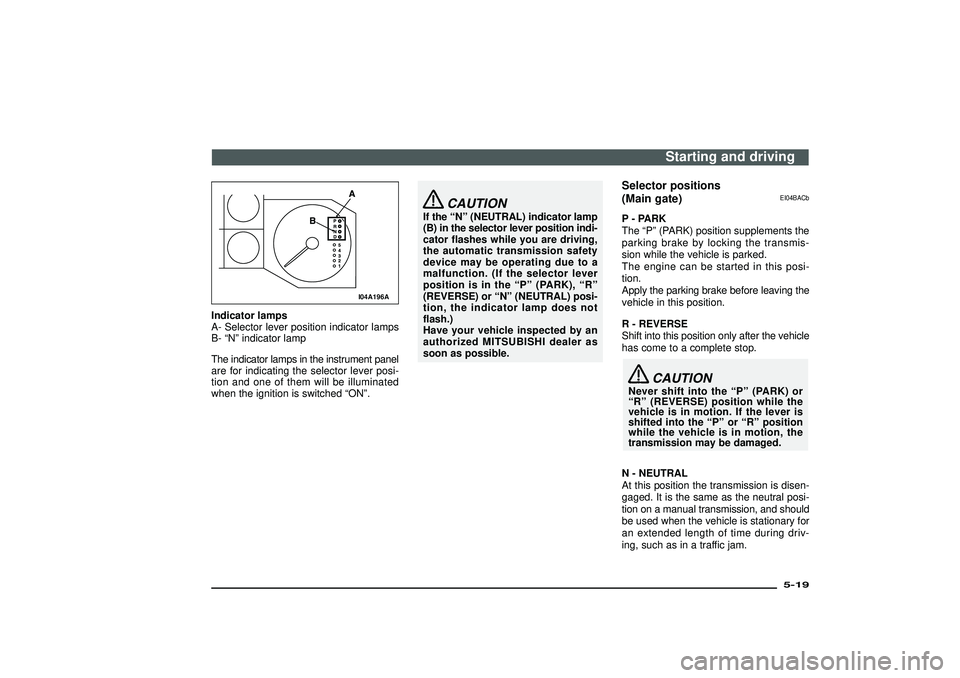
I04A196A
Indicator lamps
A- Selector lever position indicator lamps
B-“N”indicator lamp
The indicator lamps in the instrument panel
are for indicating the selector lever posi-
tion and one of them will be illuminated
when the ignition is switched“ON”.
CAUTION
If the“N”(NEUTRAL) indicator lamp
(B) in the selector lever position indi-
cator flashes while you are driving,
the automatic transmission safety
device may be operating due to a
malfunction. (If the selector lever
position is in the“P”(PARK),“R”
(REVERSE) or“N”(NEUTRAL) posi-
tion, the indicator lamp does not
flash.)
Have your vehicle inspected by an
authorized MITSUBISHI dealer as
soon as possible.
Selector positions
(Main gate)
EI04BACb
P - PARK
The“P”(PARK) position supplements the
parking brake by locking the transmis-
sion while the vehicle is parked.
The engine can be started in this posi-
tion.
Apply the parking brake before leaving the
vehicle in this position.
R - REVERSE
Shift into this position only after the vehicle
has come to a complete stop.
CAUTION
Never shift into the“P”(PARK) or
“R”(REVERSE) position while the
vehicle is in motion. If the lever is
shifted into the“P”or“R”position
while the vehicle is in motion, the
transmission may be damaged.
N - NEUTRAL
At this position the transmission is disen-
gaged. It is the same as the neutral posi-
tion on a manual transmission, and should
be used when the vehicle is stationary for
an extended length of time during driv-
ing, such as in a traffic jam.
Starting and driving
5-19
Div:
Out put date:
Page 178 of 392
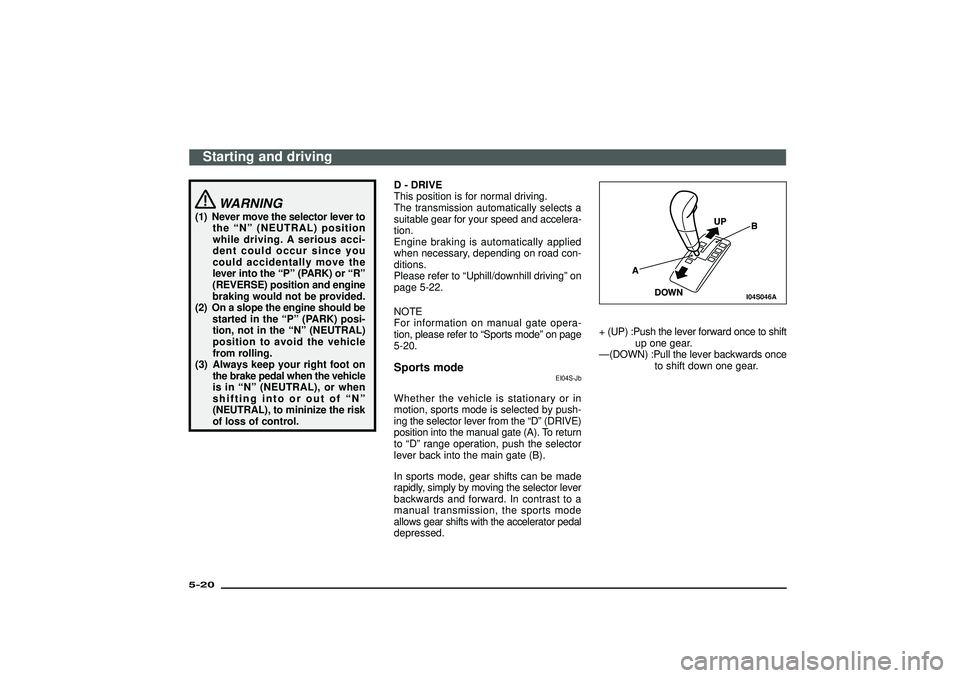
WARNING
(1) Never move the selector lever to
the“N”(NEUTRAL) position
while driving. A serious acci-
dent could occur since you
could accidentally move the
lever into the“P”(PARK) or“R”
(REVERSE) position and engine
braking would not be provided.
(2) On a slope the engine should be
started in the“P”(PARK) posi-
tion, not in the“N”(NEUTRAL)
position to avoid the vehicle
from rolling.
(3) Always keep your right foot on
the brake pedal when the vehicle
is in“N”(NEUTRAL), or when
shifting into or out of“N”
(NEUTRAL), to mininize the risk
of loss of control.D - DRIVE
This position is for normal driving.
The transmission automatically selects a
suitable gear for your speed and accelera-
tion.
Engine braking is automatically applied
when necessary, depending on road con-
ditions.
Please refer to“Uphill/downhill driving”on
page 5-22.
NOTE
For information on manual gate opera-
tion, please refer to“Sports mode”on page
5-20.
Sports mode
EI04S-Jb
Whether the vehicle is stationary or in
motion, sports mode is selected by push-
ing the selector lever from the“D”(DRIVE)
position into the manual gate (A). To return
to“D”range operation, push the selector
lever back into the main gate (B).
In sports mode, gear shifts can be made
rapidly, simply by moving the selector lever
backwards and forward. In contrast to a
manual transmission, the sports mode
allows gear shifts with the accelerator pedal
depressed.
I04S046A
+ (UP) :Push the lever forward once to shift
up one gear.
—(DOWN) :Pull the lever backwards once
to shift down one gear.
Starting and driving
5-20Div:
Out put date:
Page 179 of 392
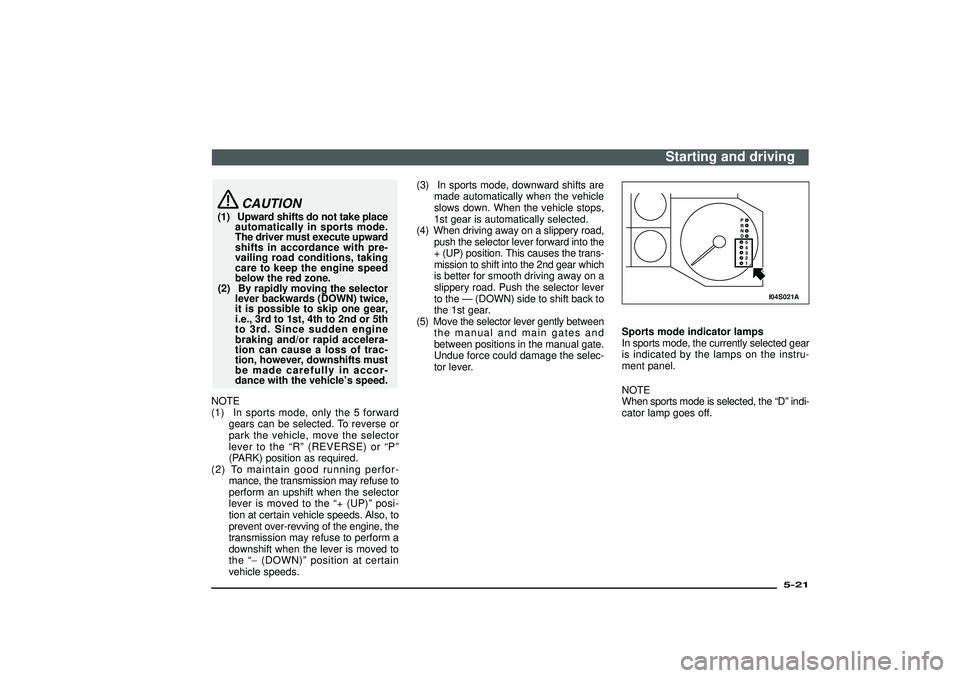
CAUTION
(1) Upward shifts do not take place
automatically in sports mode.
The driver must execute upward
shifts in accordance with pre-
vailing road conditions, taking
care to keep the engine speed
below the red zone.
(2) By rapidly moving the selector
lever backwards (DOWN) twice,
it is possible to skip one gear,
i.e., 3rd to 1st, 4th to 2nd or 5th
to 3rd. Since sudden engine
braking and/or rapid accelera-
tion can cause a loss of trac-
tion, however, downshifts must
be made carefully in accor-
dance with the vehicle’s speed.
NOTE
(1) In sports mode, only the 5 forward
gears can be selected. To reverse or
park the vehicle, move the selector
lever to the“R”(REVERSE) or“P”
(PARK) position as required.
(2) To maintain good running perfor-
mance, the transmission may refuse to
perform an upshift when the selector
lever is moved to the“+ (UP)”posi-
tion at certain vehicle speeds. Also, to
prevent over-revving of the engine, the
transmission may refuse to perform a
downshift when the lever is moved to
the“−(DOWN)”position at certain
vehicle speeds.(3) In sports mode, downward shifts are
made automatically when the vehicle
slows down. When the vehicle stops,
1st gear is automatically selected.
(4) When driving away on a slippery road,
push the selector lever forward into the
+ (UP) position. This causes the trans-
mission to shift into the 2nd gear which
is better for smooth driving away on a
slippery road. Push the selector lever
to the—(DOWN) side to shift back to
the 1st gear.
(5) Move the selector lever gently between
the manual and main gates and
between positions in the manual gate.
Undue force could damage the selec-
tor lever.
I04S021A
Sports mode indicator lamps
In sports mode, the currently selected gear
is indicated by the lamps on the instru-
ment panel.
NOTE
When sports mode is selected, the“D”indi-
cator lamp goes off.
Starting and driving
5-21
Div:
Out put date:
Page 180 of 392
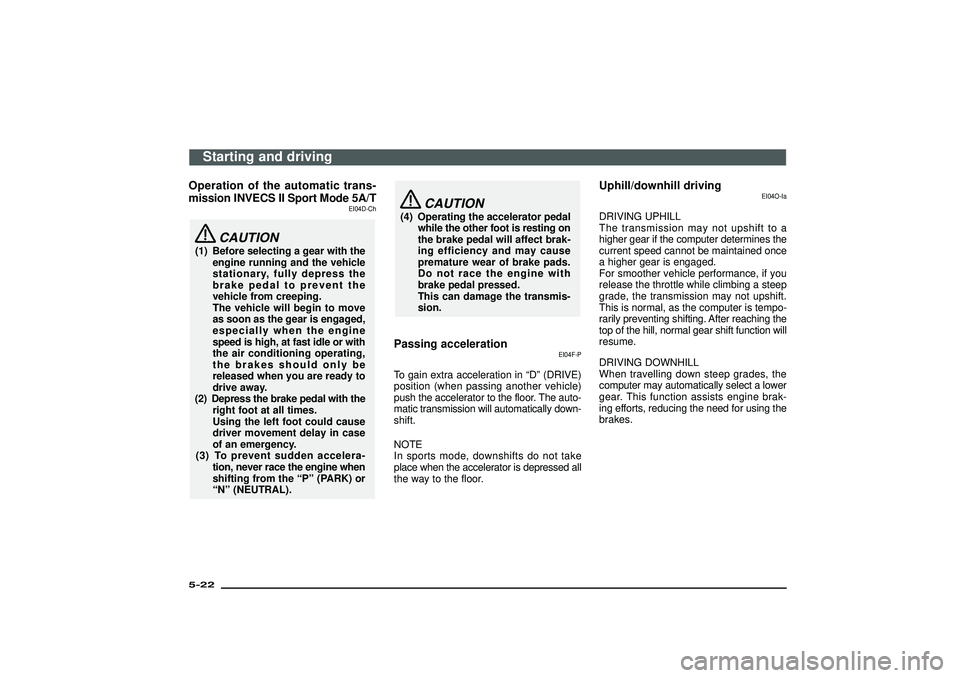
Operation of the automatic trans-
mission INVECS II Sport Mode 5A/T
EI04D-Ch
CAUTION
(1) Before selecting a gear with the
engine running and the vehicle
stationary, fully depress the
brake pedal to prevent the
vehicle from creeping.
The vehicle will begin to move
as soon as the gear is engaged,
especially when the engine
speed is high, at fast idle or with
the air conditioning operating,
the brakes should only be
released when you are ready to
drive away.
(2) Depress the brake pedal with the
right foot at all times.
Using the left foot could cause
driver movement delay in case
of an emergency.
(3) To prevent sudden accelera-
tion, never race the engine when
shifting from the“P”(PARK) or
“N”(NEUTRAL).
CAUTION
(4) Operating the accelerator pedal
while the other foot is resting on
the brake pedal will affect brak-
ing efficiency and may cause
premature wear of brake pads.
Do not race the engine with
brake pedal pressed.
This can damage the transmis-
sion.Passing acceleration
EI04F-P
To gain extra acceleration in“D”(DRIVE)
position (when passing another vehicle)
push the accelerator to the floor. The auto-
matic transmission will automatically down-
shift.
NOTE
In sports mode, downshifts do not take
place when the accelerator is depressed all
the way to the floor.
Uphill/downhill driving
EI04O-Ia
DRIVING UPHILL
The transmission may not upshift to a
higher gear if the computer determines the
current speed cannot be maintained once
a higher gear is engaged.
For smoother vehicle performance, if you
release the throttle while climbing a steep
grade, the transmission may not upshift.
This is normal, as the computer is tempo-
rarily preventing shifting. After reaching the
top of the hill, normal gear shift function will
resume.
DRIVING DOWNHILL
When travelling down steep grades, the
computer may automatically select a lower
gear. This function assists engine brak-
ing efforts, reducing the need for using the
brakes.
Starting and driving
5-22Div:
Out put date:
Page 181 of 392
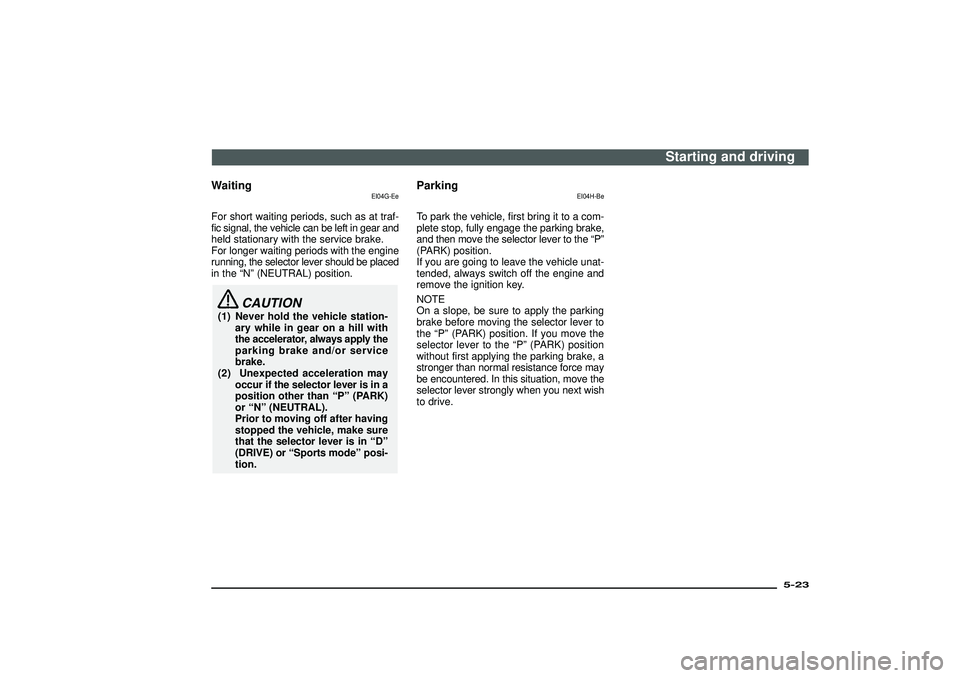
Waiting
EI04G-Ee
For short waiting periods, such as at traf-
fic signal, the vehicle can be left in gear and
held stationary with the service brake.
For longer waiting periods with the engine
running, the selector lever should be placed
in the“N”(NEUTRAL) position.
CAUTION
(1) Never hold the vehicle station-
ary while in gear on a hill with
the accelerator, always apply the
parking brake and/or service
brake.
(2) Unexpected acceleration may
occur if the selector lever is in a
position other than“P”(PARK)
or“N”(NEUTRAL).
Prior to moving off after having
stopped the vehicle, make sure
that the selector lever is in“D”
(DRIVE) or“Sports mode”posi-
tion.
Parking
EI04H-Be
To park the vehicle, first bring it to a com-
plete stop, fully engage the parking brake,
and then move the selector lever to the“P”
(PARK) position.
If you are going to leave the vehicle unat-
tended, always switch off the engine and
remove the ignition key.
NOTE
On a slope, be sure to apply the parking
brake before moving the selector lever to
the“P”(PARK) position. If you move the
selector lever to the“P”(PARK) position
without first applying the parking brake, a
stronger than normal resistance force may
be encountered. In this situation, move the
selector lever strongly when you next wish
to drive.
Starting and driving
5-23
Div:
Out put date:
Page 183 of 392

I31D019A
CAUTION
(1) Use 1st gear in the“4L”posi-
tion for very low-speed off-road
driving.
(2) Your vehicle engine should never
be operated with the engine oil
level below the MIN mark on the
dipstick. In rough terrain which
requires four-wheel drive trac-
tion, ensure that the engine oil
level is above the MIN mark on
the dipstick.
Transfer shift lever operation
EI31D-Sb
To shift transfer
case fromTo Procedure
2H 4HThe transfer shift lever can be operated while the vehicle is either moving or sta-
tionary.
In case lever operation is necessary while the vehicle is moving, place the vehicle
in the straight ahead position and depress the clutch pedal to the floor before oper-
ating the lever. 4H 2H
4H 4L
Stop the vehicle, depress the clutch pedal to the floor and operate the transfer shift
lever.
4L 4HNOTE
(1) Shifting of the lever between“2H”↔“4H”should only be made at speeds below 100
km/h (62 mph).
(2) During driving, never attempt to shift from“4H”to“4L”or vice versa.
Starting and driving
5-25
Div:
Out put date:
Page 191 of 392
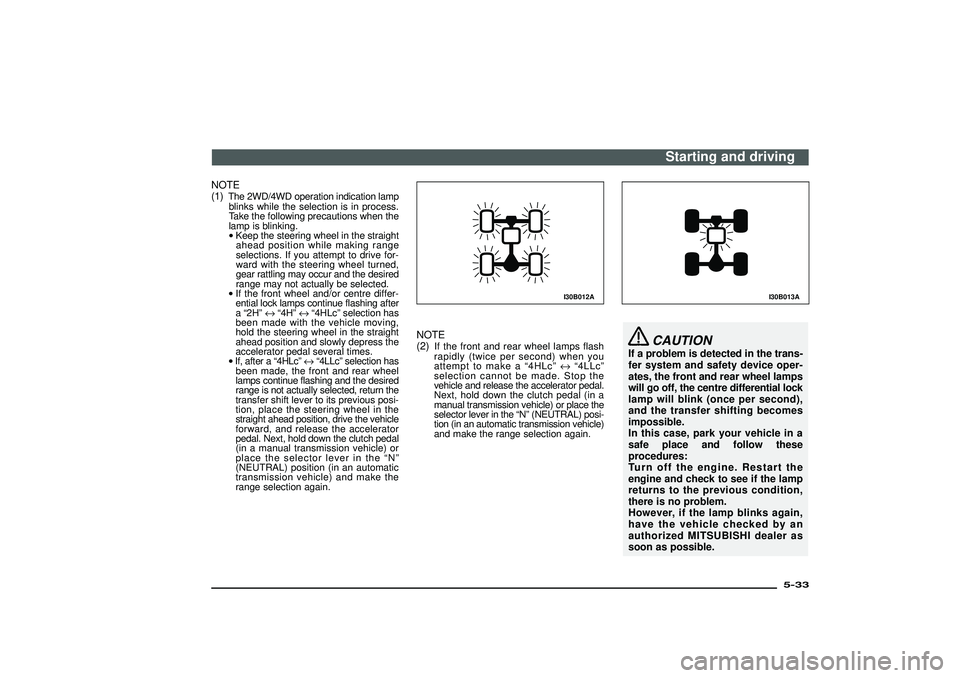
NOTE
(1)
The 2WD/4WD operation indication lamp
blinks while the selection is in process.
Take the following precautions when the
lamp is blinking.
•Keep the steering wheel in the straight
ahead position while making range
selections. If you attempt to drive for-
ward with the steering wheel turned,
gear rattling may occur and the desired
range may not actually be selected.
•If the front wheel and/or centre differ-
ential lock lamps continue flashing after
a“2H”↔“4H”↔“4HLc”selection has
been made with the vehicle moving,
hold the steering wheel in the straight
ahead position and slowly depress the
accelerator pedal several times.
•If, after a“4HLc”↔“4LLc”selection has
been made, the front and rear wheel
lamps continue flashing and the desired
range is not actually selected, return the
transfer shift lever to its previous posi-
tion, place the steering wheel in the
straight ahead position, drive the vehicle
forward, and release the accelerator
pedal. Next, hold down the clutch pedal
(in a manual transmission vehicle) or
place the selector lever in the“N”
(NEUTRAL) position (in an automatic
transmission vehicle) and make the
range selection again.
I30B012A
NOTE
(2)
If the front and rear wheel lamps flash
rapidly (twice per second) when you
attempt to make a“4HLc”↔“4LLc”
selection cannot be made. Stop the
vehicle and release the accelerator pedal.
Next, hold down the clutch pedal (in a
manual transmission vehicle) or place the
selector lever in the“N”(NEUTRAL) posi-
tion (in an automatic transmission vehicle)
and make the range selection again.
I30B013A
CAUTION
If a problem is detected in the trans-
fer system and safety device oper-
ates, the front and rear wheel lamps
will go off, the centre differential lock
lamp will blink (once per second),
and the transfer shifting becomes
impossible.
In this case, park your vehicle in a
safe place and follow these
procedures:
Turn off the engine. Restart the
engine and check to see if the lamp
returns to the previous condition,
there is no problem.
However, if the lamp blinks again,
have the vehicle checked by an
authorized MITSUBISHI dealer as
soon as possible.
Starting and driving
5-33
Div:
Out put date:
Page 195 of 392
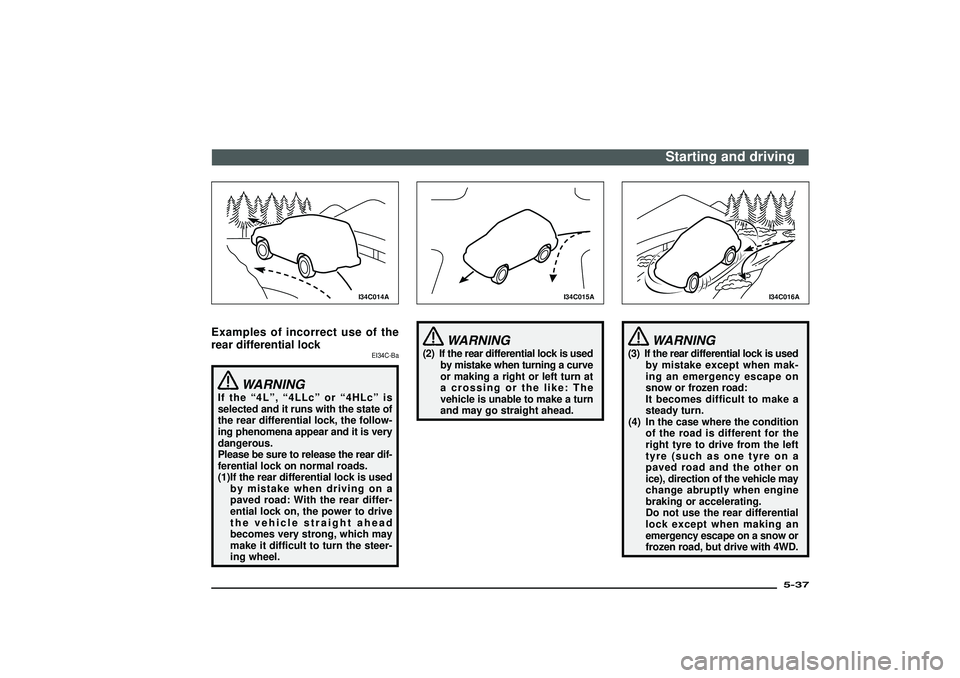
I34C014A
Examples of incorrect use of the
rear differential lock
EI34C-Ba
WARNING
If the“4L”,“4LLc”or“4HLc”is
selected and it runs with the state of
the rear differential lock, the follow-
ing phenomena appear and it is very
dangerous.
Please be sure to release the rear dif-
ferential lock on normal roads.
(1)If the rear differential lock is used
by mistake when driving on a
paved road: With the rear differ-
ential lock on, the power to drive
the vehicle straight ahead
becomes very strong, which may
make it difficult to turn the steer-
ing wheel.
I34C015A
WARNING
(2) If the rear differential lock is used
by mistake when turning a curve
or making a right or left turn at
a crossing or the like: The
vehicle is unable to make a turn
and may go straight ahead.
I34C016A
WARNING
(3) If the rear differential lock is used
by mistake except when mak-
ing an emergency escape on
snow or frozen road:
It becomes difficult to make a
steady turn.
(4) In the case where the condition
of the road is different for the
right tyre to drive from the left
tyre (such as one tyre on a
paved road and the other on
ice), direction of the vehicle may
change abruptly when engine
braking or accelerating.
Do not use the rear differential
lock except when making an
emergency escape on a snow or
frozen road, but drive with 4WD.
Starting and driving
5-37
Div:
Out put date:
Page 196 of 392
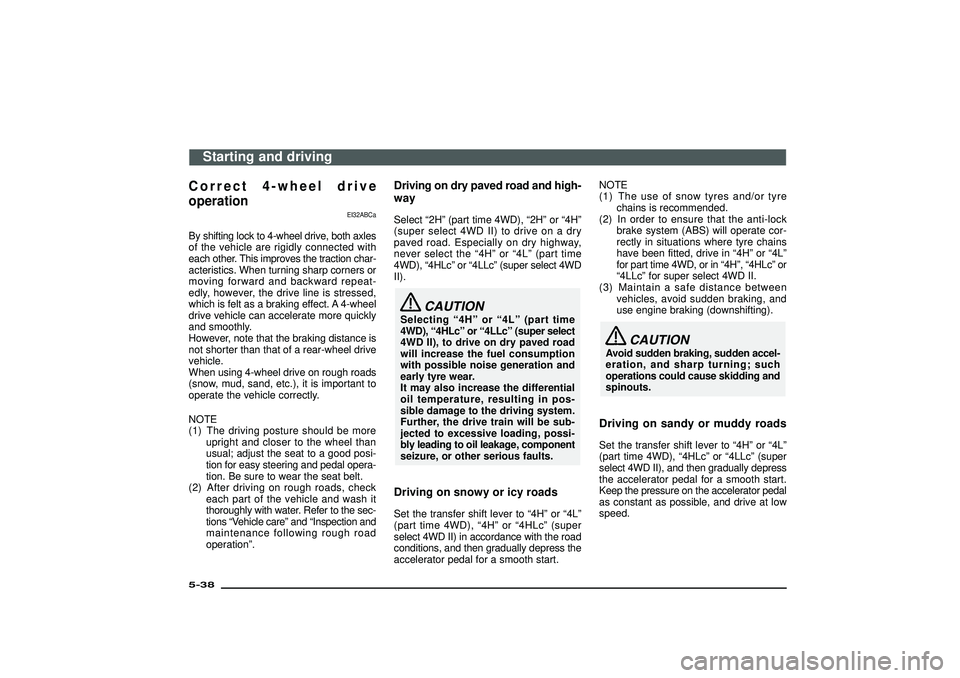
Correct 4-wheel drive
operation
EI32ABCa
By shifting lock to 4-wheel drive, both axles
of the vehicle are rigidly connected with
each other. This improves the traction char-
acteristics. When turning sharp corners or
moving forward and backward repeat-
edly, however, the drive line is stressed,
which is felt as a braking effect. A 4-wheel
drive vehicle can accelerate more quickly
and smoothly.
However, note that the braking distance is
not shorter than that of a rear-wheel drive
vehicle.
When using 4-wheel drive on rough roads
(snow, mud, sand, etc.), it is important to
operate the vehicle correctly.
NOTE
(1) The driving posture should be more
upright and closer to the wheel than
usual; adjust the seat to a good posi-
tion for easy steering and pedal opera-
tion. Be sure to wear the seat belt.
(2) After driving on rough roads, check
each part of the vehicle and wash it
thoroughly with water. Refer to the sec-
tions“Vehicle care”and“Inspection and
maintenance following rough road
operation”.
Driving on dry paved road and high-
waySelect“2H”(part time 4WD),“2H”or“4H”
(super select 4WD II) to drive on a dry
paved road. Especially on dry highway,
never select the“4H”or“4L”(part time
4WD),“4HLc”or“4LLc”(super select 4WD
II).
CAUTION
Selecting“4H”or“4L”(part time
4WD),“4HLc”or“4LLc”(super select
4WD II), to drive on dry paved road
will increase the fuel consumption
with possible noise generation and
early tyre wear.
It may also increase the differential
oil temperature, resulting in pos-
sible damage to the driving system.
Further, the drive train will be sub-
jected to excessive loading, possi-
bly leading to oil leakage, component
seizure, or other serious faults.Driving on snowy or icy roadsSet the transfer shift lever to“4H”or“4L”
(part time 4WD),“4H”or“4HLc”(super
select 4WD II) in accordance with the road
conditions, and then gradually depress the
accelerator pedal for a smooth start.NOTE
(1) The use of snow tyres and/or tyre
chains is recommended.
(2) In order to ensure that the anti-lock
brake system (ABS) will operate cor-
rectly in situations where tyre chains
have been fitted, drive in“4H”or“4L”
for part time 4WD, or in“4H”,“4HLc”or
“4LLc”for super select 4WD II.
(3) Maintain a safe distance between
vehicles, avoid sudden braking, and
use engine braking (downshifting).
CAUTION
Avoid sudden braking, sudden accel-
eration, and sharp turning; such
operations could cause skidding and
spinouts.Driving on sandy or muddy roadsSet the transfer shift lever to“4H”or“4L”
(part time 4WD),“4HLc”or“4LLc”(super
select 4WD II), and then gradually depress
the accelerator pedal for a smooth start.
Keep the pressure on the accelerator pedal
as constant as possible, and drive at low
speed.
Starting and driving
5-38Div:
Out put date:
Page 197 of 392
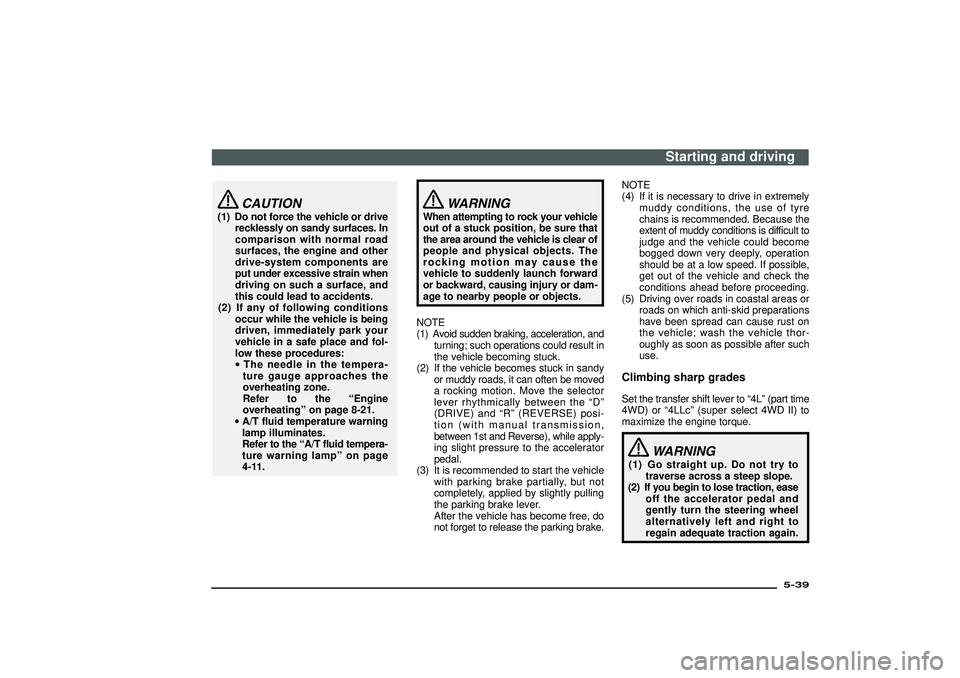
CAUTION
(1) Do not force the vehicle or drive
recklessly on sandy surfaces. In
comparison with normal road
surfaces, the engine and other
drive-system components are
put under excessive strain when
driving on such a surface, and
this could lead to accidents.
(2) If any of following conditions
occur while the vehicle is being
driven, immediately park your
vehicle in a safe place and fol-
low these procedures:
•The needle in the tempera-
ture gauge approaches the
overheating zone.
Refer to the“Engine
overheating”on page 8-21.
•A/T fluid temperature warning
lamp illuminates.
Refer to the“A/T fluid tempera-
ture warning lamp”on page
4-11.
WARNING
When attempting to rock your vehicle
out of a stuck position, be sure that
the area around the vehicle is clear of
people and physical objects. The
rocking motion may cause the
vehicle to suddenly launch forward
or backward, causing injury or dam-
age to nearby people or objects.
NOTE
(1) Avoid sudden braking, acceleration, and
turning; such operations could result in
the vehicle becoming stuck.
(2) If the vehicle becomes stuck in sandy
or muddy roads, it can often be moved
a rocking motion. Move the selector
lever rhythmically between the“D”
(DRIVE) and“R”(REVERSE) posi-
tion (with manual transmission,
between 1st and Reverse), while apply-
ing slight pressure to the accelerator
pedal.
(3) It is recommended to start the vehicle
with parking brake partially, but not
completely, applied by slightly pulling
the parking brake lever.
After the vehicle has become free, do
not forget to release the parking brake.NOTE
(4) If it is necessary to drive in extremely
muddy conditions, the use of tyre
chains is recommended. Because the
extent of muddy conditions is difficult to
judge and the vehicle could become
bogged down very deeply, operation
should be at a low speed. If possible,
get out of the vehicle and check the
conditions ahead before proceeding.
(5) Driving over roads in coastal areas or
roads on which anti-skid preparations
have been spread can cause rust on
the vehicle; wash the vehicle thor-
oughly as soon as possible after such
use.
Climbing sharp gradesSet the transfer shift lever to“4L”(part time
4WD) or“4LLc”(super select 4WD II) to
maximize the engine torque.
WARNING
(1) Go straight up. Do not try to
traverse across a steep slope.
(2) If you begin to lose traction, ease
off the accelerator pedal and
gently turn the steering wheel
alternatively left and right to
regain adequate traction again.
Starting and driving
5-39
Div:
Out put date: